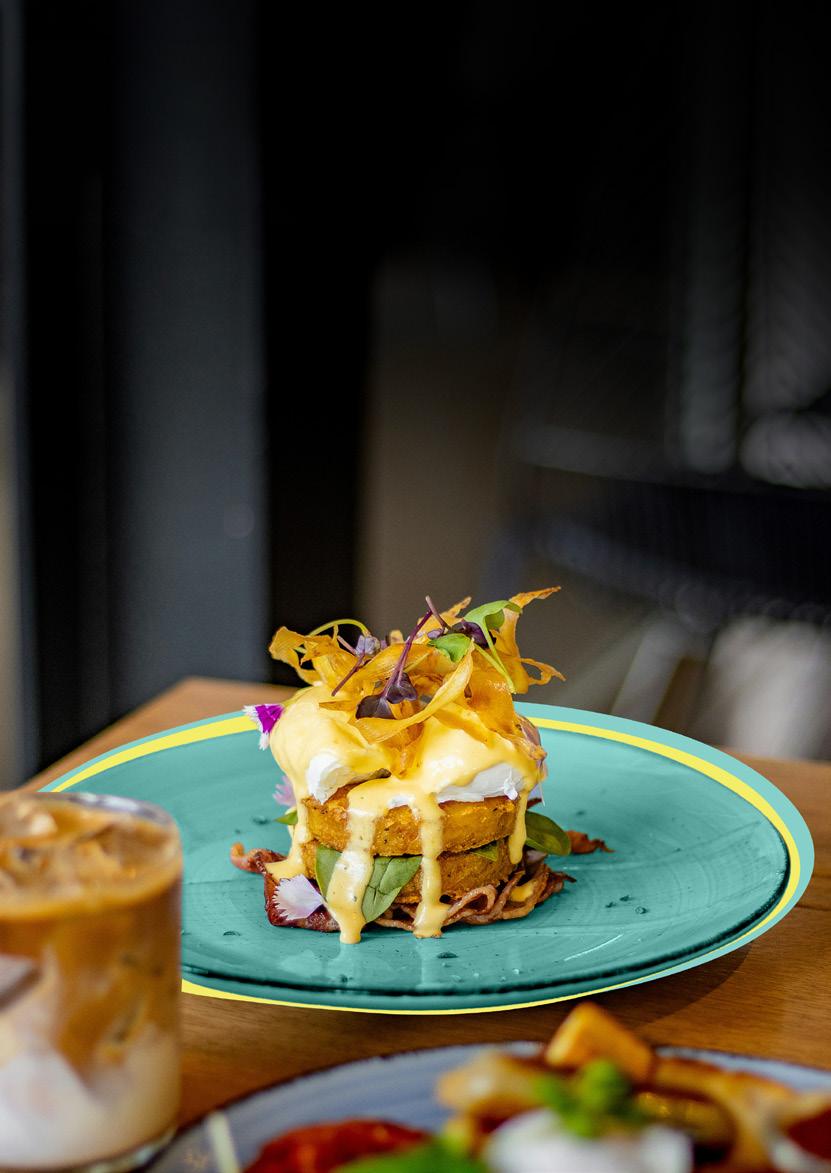

Perfecting Profitability Pantry to Plate

For help, advice or further information on anything covered in this guide simply contact our team.
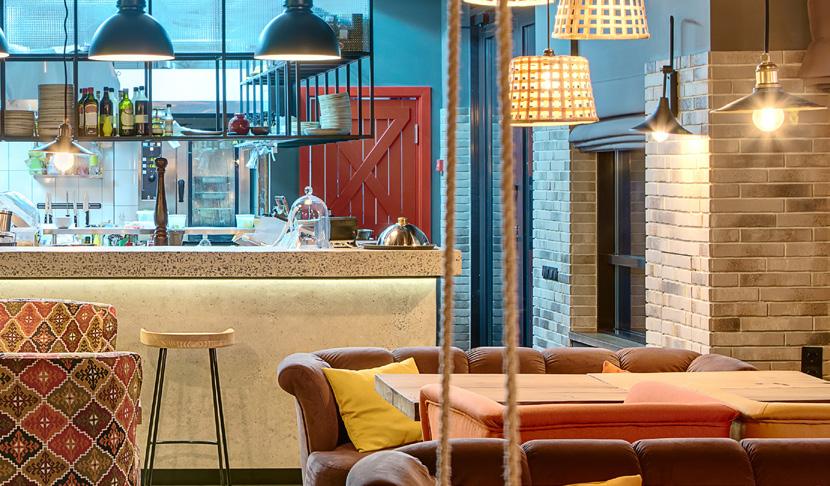
Contact: enquiries@birchallfoodservice.co.uk
01282 429446
www.birchallfoodservice.co.uk
Introduction Introduction
Irrespective of whether you began your journey in hospitality with a brilliant new dining concept, or simply have an irrepressible passion for cooking, no business will survive without turning a profit.
The key to expansion and innovation, the more pennies in every pound you can add to your bottom line, the greater your chances of seeing through the hard times and reaping the rewards when the going is good.
Food and ingredients absorb a significant share of an operator’s profits, so sourcing wisely and carefully balancing purchases with sales is inevitably high on every manager’s agenda, however profitability can be increased via a broad spectrum of additional activities.
In the hospitality sector, despite year on year growth, uncertainty seems to be the order of the day. Service-led restaurants in the independent segment have been particularly impacted by closures, increased business rates, inflation and tighter consumer spending,
while coffee shops and cafés have been able to take advantage of more consumers seeking to-go options. Whether times are good or bad, it’s always worth investigating every nook and cranny of your business to uncover gems of opportunity that will help you ride the waves as they appear.
To get you started, this guide offers inspiration and ideas that will support you on your mission to unleashing profitability from as many areas of your business as possible, so you can create a winning formula for the future.
The psych advantage
The psych advantage

How menu engineering gives profitability a boost
Whether you are a small independent operator or a large chain, your menu is one of the most powerful tools you have at your disposal. The gateway to food heaven for your customers, menus can excite and educate, but can equally disappoint. Often referred to as menu psychology, menu engineering is the practice of combining sales data with design to increase guest profitability by subconsciously encouraging customers to purchase more of what you want them to. According to the experts at Menu Cover Depot, get it right, and you can potentially increase profits by as much as 15%.
Despite offering many opportunities to maximise profitability, menu engineering is often overlooked – yet it is something that any operator can undertake, irrespective of size. The process consists of 4 steps that should be repeated periodically to continue identifying areas for improvement.
STEP 1. COST YOUR MENU
Break down every item on your menu to its individual ingredients and determine exactly how much it costs to create each dish, excluding any staffing or operational costs. While this is time consuming, it will be worth the effort.
STEP 2. MENU CATEGORISATION
Now you can see the profitability levels of each dish, categorise your menu, breaking down starters, mains and desserts into vegetarian, vegan, seafood and meat sub-categories. Using your sales data, label each dish in accordance with its profitability and popularity, placing it into one of the below four quadrants:

Getting to know your menu in this level of detail will help you determine the changes you want to make. For example, if a vegetarian main course is a Star, you may want to elevate vegan or vegetarian options in your range of starters and explore more opportunities for specials.
As a general rule of thumb, your menu should be re-arranged so that you highlight your Stars and
create more profitable versions of your Plow Horses. Items that fall into the Dog category should be de-emphasised or removed, and do some investigation into your Puzzles to find out why they are not selling as well as they should. It may be that by explaining a few ingredients in greater depth or altering the description of a Puzzle dish, you can convert it into a Star.
STEP 3. DESIGN YOUR MENU
There is no one-size-fits-all approach to this stage, menus need to be designed with your specific target customer in mind and what drives them to choose your restaurant over anywhere else. However, bear in mind the following tips for success:
• Use visual cues and descriptions to highlight the items you want to sell the most.
• The first two and the last item in any category list gain the most attention, so keep lists short and place each dish strategically.
• Don’t place prices in a column because it encourages customers to focus and select on price rather than what appeals most.
STEP 4. TEST, TEST, TEST!
Don’t assume your work is done once you have designed your menu, make sure you test it and make adjustments as needed. If you have a few design options you are considering, give each one a trial for a week or two and analyse the results to determine the right path for your operation.
From stress to success
From stress to success The benefits of a positive working environment
The hospitality industry is notorious for its high employee turnover rates, often due to the demanding nature of the work, long hours, and effort required to maintaIn high levels of customer satisfaction.
Pushing team members to their limits by spreading your staff too thin during busy periods or ignoring their health and well-being not only negatively impacts your customer experience, it can also increase your staff turnover. The higher your rates of attrition, the greater the cost to your business, not only in recruitment fees (which can cost a business 15-30% of the vacancy salary), but also in the time required to train and onboard new staff.
To reduce attrition and transform your business into an ‘employer of choice’, consider integrating some of the following strategies into your working practices:
Seven strategies for success
Addressing staffing patterns and changing the mix of skilled staff rostered at any one time can make a big difference. Offering flexible scheduling options will help employees achieve a better work-life balance by enabling them to take time off to coincide with family commitments and social activities.
Investing in training to improve upselling skills or take on new responsibilities gives staff purpose, job satisfaction and a reason to engage with your business. It also provides you with greater flexibility when it comes to scheduling shifts.
A comfortable and safe environment is foundational to employee satisfaction, so ensure that the workplace is well-maintained, has comfortable break areas, is clean and equipped with the necessary tools to support your team as they work.
Mental health is an increasingly critical aspect of employee wellbeing, especially in high-pressure sectors. Support your staff by providing resources such as access to counselling services or stress management workshops. Encouraging a healthy work-life balance by promoting mindfulness practices, facilitating adequate breaks, encouraging employees to plan time off and offering wellness programs can also help your team manage stress and reduce the risk of addiction.

Regularly solicit feedback from your team on how to improve the work environment. Implement a feedback system that demonstrates you have considered their suggestions and communicate any changes made.
Hold regular meetings to keep staff informed and engaged with your business, using this time to maintain clear and consistent communications on topics from customer feedback, shift patterns and holidays to short training sessions and business changes.
Instil a positive, welcoming company culture and managers who are team players that actively look after their staff and support a zero-tolerance policy for discrimination or harassment.
Food trends
Food trends for the coming months
With sustainability, health consciousness, and technological innovation at the forefront of consumers’ minds, the hospitality industry is facing an era of evolution rather than revolution. From plant-based menus and zero-waste kitchens to AI-driven personalisation and immersive dining experiences, the next wave of trends may not be radically different to previous years, but what they may lack in revolutionary innovation, they make up for in firmly embedding themselves in the heart of everything we do.

GROWTH IN ZERO-WASTE KITCHENS
Sustainability in kitchens will remain in place for the long term and we expect to see a rise in zero-waste or circular food concepts to reduce the enormous amount of food waste and packing materials that are thrown away each year. Nose-to-tail trends will be joined by leaf-to-root innovations as operators continue to challenge how far they can push modern cooking methods to meet sustainability goals.
AUTHENTIC CULTURAL EXPLORATION
Aguamiel and Auld Hag are two examples of operators offering diners authentic experiences that go beyond food. These venues are part of a growing movement where eating becomes an experience related to travel or traditional heritage foods, featuring authentic recipes passed down through generations and celebrating cultural diversity.
MULTIFUNCTIONAL SPACES AND INTERACTIVE DINING
There is a growing trend of multifunctional spaces that offer more than just dining. Ramen bars integrated into convenience stores or pizzerias doubling as an art gallery are just a few examples of how operators are minimising costs and taking advantage of under-utilised spaces.
Technology will continue to shape how we dine, from digital menus and contactless payment methods to augmented reality dining experiences, enhancing how diners interact with food. We expect to see more immersive dining experiences that blend physical and digital experiences going forward.
EMPHASISING QUALITY INGREDIENTS
Consumers are increasingly choosing venues based on ingredient quality, using menu descriptions to demonstrate or highlight individual ingredients. Rather than communicating simply the title of a dish such as Nduja Risotto, take a leaf out of the M&S marketing book and describe it to make it desirable. For example: “Juicy king prawns in a fiery Nduja and tomato risotto, topped with roasted sweet peppers”

Key market stats
The proportion of UK adults eating out in a restaurant increased +0.3%1 from 2022-2024. This, combined with exposure to higher business rates and inflation has created challenges for service-led restaurants.
Boosting value-credentials through loyalty and quality should be front of mind as consumers remain selective with spending. On average, consumers eat and drink out 1.41 times a week in 2024 (-0.7% vs 2022).
The number of consumers opting for drinkonly occasions has increased 0.6%1 in 2024. Greggs has achieved the most notable growth in the drinks market, combining treats with new options including iced drinks.
Dining out on Sundays has increased by 3.7%1 to May 2024 from May 2022. Dinner is the most popular day-part, highlighting the opportunity to attract consumers looking to spend leisure time with family or friends without the stress of cooking.
Delivery services are forecast to hold their share of the hospitality sector at 11% of the total eating out market. Operators are focusing on improving the user experience through AI and partnerships to expand reach.
1. Lumina Intelligence
FOOD & INGREDIENTS TO EXPLORE
Speciality honey and honey-infused products will be more widely used, as will seed-based snacks. Butter boards with cheese and honey, honey ice cream and Ethiopian curry with ginger and honey are just a few ways to incorporate the trend.
The sweet and spicy food trend of 2023 and 2024 is going up a level in heat. “Swicy” foods are heating up, from tongue-tingling Bloody Marys to re-enacting the hot-wing taste test, menus are about to have a 4th chilli added to the heat scale!

Limited edition flavours of drinks driven by seasonal ingredients will drive impulse purchases, especially within the Gen Z generation. TikTok continues to inspire the beverage market with dirty soda, slushies and the return of childhood favourites such as pink lemonade and sweetshop inspired mixes. Flavours including dragonfruit, pomegranate, apricot and mandarin are ones to watch.
Learnings from personalised sports nutrition diets will be blended into general wellness diets as the lines between the two increasingly blur. Enabling personalised blends of ingredients in smoothies, salads, sandwiches and sides that support nutritional needs will become more popular, with women’s health taking the lead.
Plant based milks are no longer just for vegans. A swathe of consumers are stocking their refrigerators with milk substitutes including oat, flax and cashew milk. These consumers are curious about plant-based milk and will be expecting to see it on menus.
Gluten-free grains such as oats and quinoa have been staples in hospitality for a while, however buckwheat is set to join them. Ground into flour, it can be used to make pancakes, cookies and bread, or used as a rice or pasta replacement for healthy plant-based meals.
For event caterers, grazing tables will continue to rise in popularity, featuring a plethora of meats, cheeses, fruits, vegetables and crackers arranged artfully on a table on natural substrates such as wood boards or banana leaves for the perfect insta-moment.
“ tiktok continues to inspire the beverage market



Created for the makers Created for the makers
Launched in 1985, the Country Range brand, with over 700 products spanning grocery, chilled, frozen, and non-food categories, is renowned for delivering the quality, consistency, and affordability that caterers need. This reputation has established Country Range as a leading name in foodservice, trusted for nearly 40 years. Available exclusively through Country Range Group member wholesalers, the brand offers a wide range of products specifically developed for professional kitchens, ensuring every detail, from pack sizes to allergen considerations and adherence to government guidelines, is meticulously attended to.
“ Take your breakfast beans to another level with our Spicy Chorizo Beans on Toast recipe

Country Range Best Sellers
From pizza dough, frozen vegetables and cheese to high quality seafood and delicious desserts, there’s much to love about Country Range products. Here are just a few of our most popular items used within the independent hospitality sector:
Country Range Unsmoked Rindless Back Bacon
Our highly acclaimed unsmoked back bacon was named Best of the Best in the Butchery category at the 2018 CCM Chef’s Own Brand Awards and has been going strong ever since. Delivering up to 42 tasty high quality, rindless back bacon rashers in each 2.27kg pack, it is a staple amongst caterers.
Country Range Baked Beans in Tomato Sauce
Available in two size options (2.62kg and 850g tins) as well as a reduced sugar and salt alternative, the humble baked bean works hard in kitchens and Country Range beans have been developed specifically for foodservice. High in protein, fibre and low in fat, it forms 1 of our 5 a day and can used throughout the day too – as a breakfast side in the morning, a jacket potato filling for lunch, or in a cottage pie for dinner.

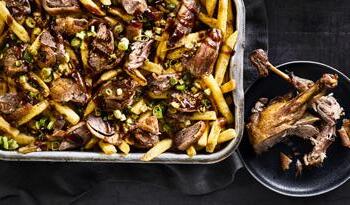
Hoisin Duck Loaded Fries
Signature by Country Range Double Crunch Skin On Fries 10mm
Available in 4 x 2.27kg bags, these pre-fried and frozen fries are produced exclusively from Fontane potatoes, giving them consistency in size, texture and flavour.
The special double crunch recipe means that they hold their crunch for up to 40 minutes which makes them a winner in busy kitchens.
Read more about the Signature premium product range below.
Country Range Orange Juice
100% pure orange juice from concentrate and available in 12 x 1L cartons, this is the ideal beverage for cafés or B&B operators offering breakfast to guests, but it goes much further than that! From baking to seafood, ham glazes and vegan dishes, orange juice is your kitchen’s flexible friend.
Country Range Grated Mozzarella
Offering versatility and outstanding flavour, our grated mozzarella is available in 6x2kg bags. Use it for pizzas, paninis, pastas, Mexican dishes or a simple topping for deep filled potato skins.
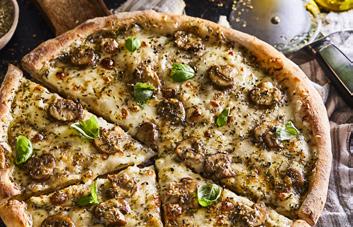
“ Take a look at our Mushroom Pizza recipe which uses Country Range Bechamel Sauce as a base instead of tomato for a luxuriously creamy finish

Behind the Brand
As a team, we are continuously evolving our product range to meet the needs of caterers, guided by our in-house professional development chef who ensures our products align with emerging food trends. New ideas are developed and sourced within a rigorous NPD framework to ensure all products deliver good quality and value for our customers.
The quality, consistency, and safety of our products are central to our operations. Our in-house Quality Manager regularly audits our suppliers, who are BRC or SALSA accredited where relevant. We have a robust product feedback and complaints procedure, and our products undergo frequent testing in our central office’s development kitchen to maintain accurate specifications. Weekly product testing sessions, along with regular benchmarking against branded and other own-brand products, ensure our offerings meet the highest standards.
To reduce our impact on the environment, we are committed to reducing excessive packaging, moving towards more recyclable and biodegradable solutions.
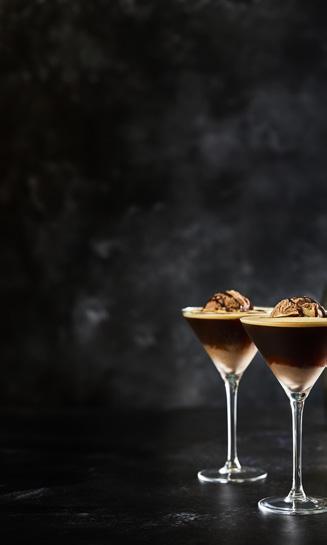
Over the years, the Country Range brand has evolved to include Signature by Country Range, our premium selection of products. With exclusive new products launched throughout the year, our Signature product tier allows for greater innovation and variety for customers, ensuring every item incorporates at least two of the following distinctive features:
• Provenance
• Premium quality ingredients
• High ingredient content
• A unique story behind the ingredients or manufacturing process
Find out more about Signature products and solutions to elevate your menu from your Country Range wholesaler or by visiting countryrange.co.uk
Managing allergens
Managing allergens in the kitchen
The number of consumers with food allergies is on the rise. Research by the Food Standards Agency reports that 6% of the adult population (2.4million adults) have a clinically confirmed food allergy, although the Patterns and Prevalence of Adult Food Allergy (PAFA) found that more than 30% of adults reported some form of adverse reaction when eating food (meaning they had an illness or trouble after eating a particular food). The report also found that foods such as peanuts, hazelnuts, walnuts and almonds were most likely to cause an allergic reaction.
“ 6% of the adult population have a clinically confirmed food allergy
TO PROTECT THE SAFETY OF ALL GUESTS, ESPECIALLY THOSE WITH FOOD ALLERGIES, THE FOLLOWING PRACTICES ARE RECOMMENDED:
STAFF TRAINING
Implement mandatory training and refresher courses to keep staff updated on best practices in front and back of house, including emergency response in case of an allergic reaction on your premises.
COMMUNICATION
Establish a clear communication protocol for handling allergen information between front-and-back of house, ensuring all guests are asked about allergies when orders are taken.
DETAIL INGREDIENTS LABELLING
Clearly label all food items and ingredients in the kitchen, especially those containing allergens.
CREATE ALLERGEN-FREE ZONES
Dedicate preparation areas for allergen-free dishes to minimise the risk of cross-contamination and clearly mark utensils, cookware and cutting boards that are used for allergen-free preparation.
MENU DEVELOPMENT & TRANSPARENCY
Clearly indicate which menu items contain common allergens so consumers can make informed choices. When developing your menu, identify dishes that can be made without any of the common allergens and have clear protocols for substituting ingredients to cater for a broader consumer group.
REGULAR REVIEWS & AUDITS
Work closely with suppliers to verify the allergen status of ingredients and conduct regular audits of your internal practices to ensure compliance with legislation.

The Country Range Group is delighted to be the first foodservice provider to partner with The Natasha Allergy Research Foundation, embarking on a comprehensive journey to raise compassion, understanding and vital funds to help make food allergy history.
The charity’s vision is to eradicate allergic disease and help prevent food allergy deaths, but it also aims to bring about positive change by focusing on law and policies, investing in medical research, education and raising allergy awareness. The partnership will see the Country Range Group and our members work alongside the charity to help drive the delivery of its objectives such as the Natasha Clinical Trial.
THE 14 MOST DANGEROUS ALLERGENS IDENTIFIED BY THE FOOD STANDARDS AGENCY ARE:
Celery
Cereals containing gluten (found in barley and oats)
Crustaceans (such as shrimps, crabs, and lobsters)
Eggs
Fish
Lupin
Milk
Molluscs (such as mussels and oysters)
Mustard
Nuts
(almonds, hazelnuts, walnuts, brazil nuts, cashews, pecans, pistachios, and macadamia nuts)
Peanuts
Sesame
Soybeans
Sulphur dioxide and sulphites (if at a concentration of more than ten parts per million (ppm))

Coconut Mousse
This rich and creamy mousse is free of all of the 14 allergens, making it a safe menu option, whilst also being suitable for vegans. Try adding the zest of a lime to give it some freshness and zing.
INGREDIENTS
1 400ml tin Country Range
Coconut Milk
Pinch Country Range
Ground Ginger
Pinch Country Range
Ground Cinnamon
100g Country Range
Frozen Summer Fruits
½ tsp icing sugar
METHOD
1. Place the tin of coconut milk in the fridge for one hour. You want the fat to solidify and liquid to separate.
2. Once cold, open the tin and scoop out the solids, keeping the liquid for curries or drinks.
3. Whisk the coconut milk solids until light and fluffy and add the ginger and cinnamon.
SERVES: 2 TIME TO PREPARE: 20 MINS
4. Carefully spoon into two glasses and give them a gentle tap to remove any air bubbles and to level the mousse.
5. Defrost the summer fruits and stir in the icing sugar.
6. Top each glass with the fruit and serve.
A profit perspective A profit perspective Making the meat

Approximately 16% of the UK population are following a meat-free diet
Whether you own a restaurant, manage a business or operate a kitchen, understanding veganism is crucial to operating a successful restaurant. The figures speak for themselves, not only is veganism growing, but so are the percentage of people electing a meat-free lifestyle in general.
Although it can easily be argued that there is a huge disparity between the number of people planning to adopt a meat-free diet and those who actually do, as a consumer, knowing that your favourite restaurant can support your lifestyle decisions goes a long way. Approximately 8.6million1 adults in the UK are currently following a meat-free diet, equating to 16% of the population, increasing by 20% since the start of the previous year.
“ In line with the increasing vegan trend, vegan hotels are now also emerging
Dietary Choice by Generation
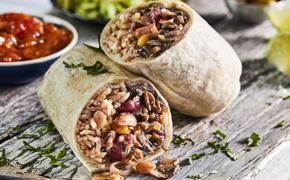
Vegan Burrito
Whether serving as a grab and go option or as part of a main course, burritos are a great way to pack a punch with flavours without the need for meat.
INGREDIENTS
DEMOGRAPHIC AGE GROUP
A VEGAN MENU IS JUST GOOD BUSINESS
The latest numbers indicate that there are an estimated 2.5million adults adopting a vegan or plantbased diet in the UK. This translates into 1 in every 13 households, so if you don’t want to miss out on those all-important group bookings and private events – ensuring your menu caters for vegans is a must.
Crafting a strong range of vegan starters, mains and desserts not only broadens your customer base, but it also means your restaurant is automatically ready to cater for practically any customer who walks through your doors. Vegan dishes tend to be very inclusive and suitable for a number of dietary requirements including:
• Vegetarians & pescatarians
• Lactose intolerant diners
• Customers seeking to reduce meat in their diet
• Customers trying to lose weight or reduce cholesterol
• Religious dietary requirements (kosher and halal – if no alcohol is used)
PERFECT FOR PROFIT
Not only does catering for vegans make good business sense, vegan food has the added advantage of requiring less expensive ingredients, resulting in opportunities for higher profit margins. Ingredients also have a longer shelf life, helping operators maximise the yield out of their inventory.
Operators can also incorporate many vegan ingredients in nonvegan dishes to prevent duplicating purchases. Condiments such as vegan mayonnaise or plant-based milk can work just as well as their dairy counterparts in many dishes.
1 in 13 households are adopting a vegan
or plant-based diet
HITTING THE MARK
Whether switching to a meat-free diet for environmental reasons, or to live a healthier lifestyle, the surge in the sector is largely driven by the younger generation. It is therefore realistic to assume this trend will continue over the coming years as Gen Alpha grow into adulthood, changing the balance of the scales eventually so that the market is dominated by meat-free consumers. We are already seeing this play out – Gen Z, the biggest consumer group for plant-based meals state eating out is a major spending priority and 50% 2 of millennials (aged 26-35) view drinking and dining as essential spending. Although in real terms, it’s Gen X who spend the most on dining out overall, it is clear that the market is shifting.
1. Finder (April 2024) How many vegetarians and vegans are in the UK in 2024?
2. www.designmynight.com consumer survey
Refried Beans:
400g Country Range Five Bean Salad
1tsp Country Range Ground Cumin
SERVES: 2
TIME TO PREPARE: 30 MINS
½ tsp Country Range Smoked Paprika
1tbsp Country Range Tomato Puree
1 diced onion
1tbsp vegetable oil
2tsp chilli sauce
1tsp brown sugar
Juice of 1 lime
1tsp salt
Burritos:
2 Country Range 12” Tortilla Wraps
75g Country Range Basmati Rice (cooked)
50g Country Range Salsa
1tbsp chopped coriander
25g grated vegan cheese
METHOD
1. Soften the diced onion in a frying pan and stir in the spices.
2. Cook for two minutes before adding the tomato puree, chilli sauce, sugar and lime juice.
3. Add the beans and salt and around a cup of water. Season to taste.
4. Simmer gently until the water is almost evaporated.
5. Warm the tortilla wraps and place a spoonful of warm, cooked rice in the middle.
6. Add a spoonful of the refried beans on top, followed by the salsa, vegan cheese and chopped coriander.
7. Roll tight into a burrito and wrap in tin foil. Warm in the oven for five minutes.
8. Cut in half and serve with guacamole and more salsa.
family time family time Encouraging
Mastering the art of family dining should be high on most operators’ agendas. Staycations, family celebrations and days out often involve an evening meal or lunch at a restaurant which (when you are ill-prepared), could turn an evening’s trade into a disaster. With differing tastes and needs, catering for families can be complex – it may be sorely tempting to rely on perennial favourites such as chicken nuggets and chips to get by, but that’s not necessarily what parents want for their children.
CONQUER THE BASICS
Whether you want to pitch your restaurant as family friendly, or simply want to broaden your target market, equipment such as high-chairs and child-friendly cutlery goes a long way to ensure children are sitting securely and are safe. Staff training is also a must. Waiting staff need to be cognisant of what they place on the table and where, ensuring sharp cutlery, hot drinks or hot plates are not within reaching distance and that children’s drinks are served in appropriate drinkware to prevent breakages.
As the world becomes increasingly digital, and we continue to welcome generation Alpha - the first generation to be exposed and brought up on technology from birth - making sure you have plenty of charging points in your restaurant is a must. Parents are often entertaining their families using mobile phones and tablets instead of colouring books, so ensuring their devices don’t run out of power mid-meal will help keep everyone happy.
CASH IN ON CELEBRATIONS
If you want to offer your restaurant as a venue for children’s parties or family celebrations, think about providing a complete package including email invitations, allergy forms and birthday cake to make life easier for parents. Contact other local businesses in the area and build a little-black-book of suppliers who can help you with any supplies or services you may need. On average, parents spend £3501 on a child’s birthday party, so getting it right could be a lucrative activity to help boost sales during quieter times of the day.
1. Vouchercloud.com: Cost of Children’s Parties

MENU INSPIRATION
To engage families with young children, make kids’ menus bright and fun with dishes presented in a creative way, using photos to aid self-selection for children who are learning to read and clear allergy information identified for parents. When developing your menu, try not to add more than 5 options to give them autonomy to choose without overwhelming them. Some tips include:
• Add kids’ portions of popular adult meals such as vegetable lasagne, shepherd’s pie or baked salmon with vegetables will ensure they get the nutrients they need and do not over-rely on chips.
• Use colour to your advantage, a bright quinoa rainbow salad is packed with whole grains but also makes healthy eating appealing to children.
• With an increasing number of children opting for a vegetarian or vegan diet, be sure to include plenty of meat-free dishes that include proteins such as pulses or tofu.
• For starters, try using crinkle cutters on raw vegetables to make them more tactile and appealing as finger food. Raw veg is perfect as a starter with hummus, roasted butternut squash dip, baba ganoush or cream cheese and can be quickly served to keep children entertained at the table.
• Make healthier versions of classic favourites such as baked or grilled homemade fish fingers and breaded chicken instead of fried.
• Minimise food waste by giving children the option to add their choice of vegetables – kids are often put off by one element of a meal they don’t like, which causes excess waste.
The business case for
reducing waste
reducing waste
Reducing food waste has been on the menu for all caterers for quite some time, however we are not always privy to the hard-hitting facts behind the volumes involved and the impact it has on an operator’s profitability. Research has found that a typical kitchen will waste between 5-15%1 of the food they purchase due to over-production. A whopping 70% of the value of all food waste in hospitality occurs before food reaches the consumer.
EVERY PENNY COUNTS
Not only does reducing food waste positively impact profitability, it has the additional benefit of reducing the volume of work in kitchens, ensuring chefs are not wasting precious time over-producing and prepping food that will end up in the bin.
The cost of this waste to the sector has been estimated at £3.21billion2 per year, so how can your operation win some of this bounty back?
HERE ARE SOME TIPS TO GET YOU STARTED:
Measure your food waste and quantify the volume so you can see how much and where food is being wasted. Automating waste tracking using built-in cameras, AI or apps to support menu development can prevent 3x 3 more waste than manual methods.
Engaging your staff is key to achieving success. Teams need guidance and leadership to understand the bigger picture and their role in the process. They may also surprise you with some great ideas and initiatives that achieve big results, so involve them wherever possible.
Reduce overproduction by analysing sales, assessing portion control and looking at methods to change the way side dishes are presented – for example, can you offer a choice of three sides to be included in a Sunday Roast instead of piling the plate full of five different types of veg?
If you want to get started and increase your profitability by reducing food waste, The Waste and Resources Action Programme (WRAP) have agreed a set of common guidelines in conjunction with several UK food businesses for measuring and reporting on food surplus and waste. Head to www.wrap.org.uk and download the kit for more information. 1 2 3 4 5
Rethink your inventory and purchasing practices to optimise your stock. This could take the form of negotiating a different delivery schedule to fit your needs, keeping inventory up to date so you don’t over-buy, deploying a first, in first out stock system or labelling containers containing decanted food to prevent unidentifiable contents getting thrown away.
Repurpose excess food to prevent any unsold items going to waste, make soup stock from peels, seeds, skins and bones, produce daily or weekly specials to make use of leftover ingredients or donate food to a foodbank. Although donating food doesn’t yield any direct financial reward for your business, it is a feel-good activity that can be widely marketed as sustainable practice.

On average 34%4 of food waste comes from consumer plates, so think carefully about portion control, analyse whether the side-salad or garnish is being eaten and consider whether you should reduce the amount of bread served at the start of a meal.

WHY SUSTAINABILITY IS NOT JUST GOOD FOR THE ENVIRONMENT
Whilst there are some environmentally conscious decisions we make that have clear cost savings, others are a little more difficult to identify. When it comes to sustainable practices, not all are about saving money but that doesn’t mean they should be ignored. A survey on behalf of the Sustainable Restaurant Association revealed that over 80% of respondents said that a restaurant’s sustainability practices had been a deciding factor when choosing where to eat. Although composting food waste and speaking to suppliers to cut down on packaging and use recyclable materials doesn’t directly impact the bottom line, it clearly means something to your customers who do!
More often than not, operators are overwhelmed when it comes to deploying sustainable practices. Rather than tackle the big-stuff, try making the following small changes instead and you will be surprised at how they add up...
Reduce printed receipts – It is estimated that restaurants print 811 million bills and receipts every year in the UK – an average of 9,361 receipts per restaurant that cannot be recycled due to the chemicals used to produce them. Think about how you can go paper-free by asking customers if they want a receipt, using technology to email them instead.
Turn off the lights – We are not suggesting you start working in the dark! Switching off lights when you close or in offices that are not used during the day will save your energy bills and the planet at the same time. In a similar vein, turning your heating down 1-2 degrees will also have a big impact on your energy bills. If you want to take this idea one step further, consider installing motion sensor lighting and motion sensor taps in bathrooms to save water.
Switch single use plastics – Using biodegradable bin bags, reusable storage boxes instead of clingfilm and removing single use plastics from takeaway or delivery cartons all contributes to a more sustainable future.
Maintain kitchen equipment – Checking the performance of critical appliances such as refrigerators and freezers plays an important role in preserving ingredients and reducing food waste. While a new fridge or freezer may not be cheap, it will serve you well over time and an increasing amount of equipment can be given a new lease of life with a good repair.
Buy local – With less shipping time and more frequent deliveries you will no longer need to stock up on ingredients which may go to waste if left unused, and you are more likely to buy produce when it is in season. Not only is this more cost effective, across the market, operators are increasingly emphasising locally-sourced, seasonal ingredients on their menus in response to a growing consumer demand for environmentally responsible and ethically produced food.
Case Study
Beaufort Hospital in Washington, recently expanded their waste reduction project to include plate waste from patient trays. Using technology, the team tracked how much food was left on the plates of patients at the end of each meal to identify any commonly wasted items. By adjusting menus, ordering times and placing items such as condiments on demand rather than giving each patient a small selection of everything, the team saw a reduction in plate waste of 24% within months.

A survey, produced by CGA in association with UKHospitality, found that over four in five respondents (83%) expect hospitality brands to take part in sustainable practices and 41% said they’d be willing to pay more for sustainable dining.

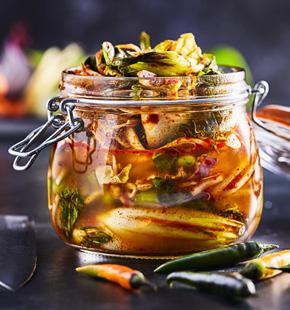
Kimchi
This increasingly popular Korean side dish is extremely versatile and a great way to use up leftover vegetables. You can use this recipe as a guide and include the vegetables you have in your kitchen.
INGREDIENTS
½ cabbage cut into wedges
4 spring onions, sliced
1 carrot, grated
2 bok choi, quartered
50g edamame beans
25g grated ginger
4 cloves garlic, grated
3tbsp sriracha sauce
3tbsp rice wine vinegar
2tbsp sea salt
METHOD
SERVES: 8 TIME TO PREPARE: 30 MINS
1. Place the washed cabbage and pak choi in a bowl with the salt and massage all of the leaves, ensuring you get into the crevices. Cover and set aside for one hour.
2. Add the rest of the vegetables to the bowl and leave for one more hour.
3. Wash off the salt from the vegetables and add the ginger, garlic, sriracha and rice wine vinegar. Ensure that all of the vegetables are coated in the juices.
4. Pack tightly into a large, sterilized, sealable jar and top with all of the juices until the vegetables are completely immersed in the liquid.
5. Seal the jar and leave to ferment for 24 hours at room temperature.
6. Place in the fridge and this will keep for up to two weeks.

Improving the profitability of any operation combines multiple disciplines and activities. On average, food contributes 40% to an operator’s overall costs, so it is important not only to get the right sources of supply, but to ensure the sales opportunities for dishes are maximised throughout the business. To boost your bottom line, think about making any of the following tweaks to your operation:
Connect with your community
Sometimes it’s easy to overlook activities that mean the most to your customers. With mental health and social isolation a growing problem, consider how your business can actively improve lives in your community. Initiatives such as Chatter & Natter tables – providing a place for customers to sit and converse with others are a great idea to help reduce loneliness. Businesses benefit from the opportunity to attract more customers outside peak hours, repeat business and receive promotional exposure with support from the Chatty Café Scheme organisers on social media, in the local press and on websites.
Alternatively, if your venue allows dogs, think about how you can cater for them. Anita Gelato in Covent Garden serves a range of dog-friendly vegan sorbets while The Egerton House Hotel offers the Doggy Afternoon Tea with treats such as chicken and beef meatloaf, homemade dog biscuits and a carrot cupcake. The team at Old Dunnings Mill in East Grinstead offers a three-course menu with dishes such as chicken and vegetable stew or beef meatballs with bone broth and for dessert – dog ice cream!
Food for thought... Food for thought...
Whenever you make a change to your business which positively impacts your diners, don’t forget to promote it as widely as you can through social media, blogs, email campaigns, in-store communications and local press.
Improve customer return rates
Without dedicated software to track and manage customer details, it can be difficult to measure how often customers return to dine at your restaurant, but that doesn’t mean you can’t entice them! Think about deploying similar tactics to retailers, giving a discount code on a customer’s receipt for future use or rewarding frequent customers with a free coffee or petit fours to make them feel appreciated. You may be surprised how a little effort goes a long way.

Diversify
Improve the average spend per head
While broader goals like expanding sales or optimising operations might appear daunting, elevating your customers’ average spend is a more achievable objective with a bigger impact. By dividing your total sales by the number of customers served, you get a view of your current average spend per head and from here you can try to increase it without simply raising prices. Strategies such as upselling sides and sauces or drinks pairings are easy to implement. Alternatively, you can break through the pricing barrier with sharing platters or offer a number of small plates for customers to select from and share. To entice diners, think about offering four plates for the price of three, keeping the number low enough for small groups to benefit from the offer and order one or two dishes more, drawing on the propensity to over-order when diners are sharing.
for thought... for thought...
Identify time saving opportunities
There are numerous ways to save time throughout your business; from batch cooking to standardising recipes, training and inventory management, but with the increased use of technology, digitisation is helping operators bridge the staffing gap and become more efficient.
We are increasingly seeing robots taking front of house positions, with tens of thousands of robot servers currently gliding through dining rooms around the world. Users are reporting a more efficient service as well as easing the workload for staff. The novelty of such technology is exciting younger generations and entertaining the techcurious, creating a marketable, unique dining experience.
We have consistently seen significant levels of innovation from the hospitality sector. Chefs such as Rick Stein and Angela Hartnett were among many others to introduce à la carte home delivery recipe kits which have gone down a storm with consumers. Other initiatives include dark kitchens or using school kitchens to provide a takeaway service and opening premises to enable private functions such as corporate events and weddings to fill a potential gap in the locality.
Improve table turn
It’s no big secret that the more customers you can serve, the greater your turnover, but achieving this without turfing customers out after a set period of time can be difficult. Think about how you can improve your workflows, incorporating front and back of house to minimise waiting time. Shortening your menu for breakfast, brunch or lunchtimes with specials that can be quickly executed will help you turn tables faster without pressurising your guests.
Pre-prepared bowls of overnight oats, smashed avocado on toast or fruit loaf with orange mascarpone cheese is much quicker to serve than a breakfast burrito or shakshuka. Similarly for lunch, hearty bowls of homemade soup served with a cheese scone or chunk of bread and flavour-filled pasta salads are faster to produce than a layered tuna melt sandwich, a hot chicken salad or fresh poke bowl.
Turn dining out into an event
Creating a themed fixed menu event attracts diners seeking an experience. Try creating a mid-week event to encourage diners out during quieter periods, using your email subscriber database and in-house leafleting to market it. For example, an Italian restaurant might craft an exclusive menu specific to a particular region in Italy, with a sommelier who talks customers through different wine pairings as they complete each course. Dining experiences do not always have to be lavish affairs, however they do need to offer something different to your regular menu in order to be memorable and attract bookings, so involve your team and get creative.
